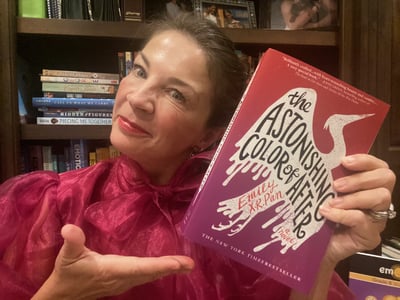The Astonishing Color of After, by Emily X.R. Pan, is a New York Times bestselling author. The novel has won several awards - the APALA and the Walter Honor Award. It was also a finalist for the LA Times Book Prize, long-listed for the Carnegie Medal, and named one of the 100 Best YA Books of All Time by TIME Magazine. This book is a definite winner! I loved this book as the imagery is beautiful, the story is heartbreaking and meaningful, and I enjoyed learning about the Taiwanese culture and country.
Overview
This book addresses the heartbreak of a family when Leigh's mother commits suicide after struggling with depression for years. At the same time, Leigh is grieving the loss of her mother, she is also dealing with teenage problems, relationships, and friendships, and finding a connection with grandparents she has never met.
This story also has a fantasy theme: Leigh is awakened by a sound at the door the night before her mother's funeral. Leigh watches as a bird lands on her front porch. She is convinced that her mother has turned into a crimson bird. Leigh struggles to deal with her mother's death, and the bird encourages her to visit her grandparents in Taiwan.
The story moves from reality to fantasy and back, blurring the lines between them until they become one. The relationships between Leigh and her two friends, Axel (with whom the relationship may or may not transform from friendship into something more) and Caro, are affected by the death of her mother as well, and Leigh struggles to connect with them as she had in the past. Leigh must go to Taiwan. There she meets her grandparents and learns more about her mother and the family she never knew. Through this experience, Leigh begins to accept the loss and try to move forward.
Our fact for this novel is sobering. In nearly 50% of all suicides, depression is involved, and those suffering from depression are 25 times at greater risk. If you are affected by a loved one that has committed suicide, there are some things that you might need to know.
First, there is no "right' way to feel about what has happened, and we all do not experience loss similarly. However, this loss might feel different than other types of loss, making the healing process more challenging. One major difficulty is the stigma attached to suicide; different cultures or religious views might make it more difficult to discuss what has happened.
Some healthy ways to cope with grief and loss include seeking supportive groups, friends, or mental health professionals to share your feelings and acknowledge your experience. Be patient and gentle with yourself as you take time to heal. Try to be present in the moment—mindfulness can help. Don't deny yourself pleasure or fun—it's ok to feel however you feel. And, try to keep your routines and take care of yourself—be mindful of your body budget (sleep, nutrition, exercise, etc) and avoid things that may make it harder to work through your feelings, like alcohol or drugs.
If you are experiencing depression and are entertaining suicidal thoughts, please call the Suicide and Crisis Lifeline at 988 or visit their website at 988lifeline.org.
 Socratic Seminar Questions
Socratic Seminar Questions
The first chapter deals with Leigh coming home to discover that her mother has committed suicide. - What emotion words do you think Leigh might have been feeling? How would you describe how you felt reading that first chapter?
- What color do you think she might have chosen and why?
- Why did Leigh leave so abruptly after the kiss? What do you think she might have been feeling? What do you think she might have been thinking?
- What does she mean by this? Why do you think she feels it's easier to pretend the stain is acrylic paint? Is it always easier to pretend in the face of something horrible? Why or why not?
- What might a mother want her child and husband to remember? What would be important to remember for you about those you love? What would you want them to remember about you?
- What do you think the bird as her mother represents? Does seeing this bird bring Leigh comfort or not?
lessons that connect to the SEL themes in this book
Grade 9- Lesson 3: Emotional Granularity
- Lesson 5: Visualization
- Lesson 9: Stress Management
- Lesson 14: Healthy Relationships
- Lesson 15: Apologies and Forgiveness
- Lesson 17: cultural competency
- Lesson 27: Resilience and Perseverance
- Lesson 2: Strengths and Interests
- Lesson 6: Point of View
- Lesson 9: Stress Management
- Lesson 19: Showing Respect
- Lesson 20: Conflict Resolution
- Lesson 5: Diversity
- Lesson 6: Perspective
- Lesson 10: Emotional Granularity
- Lesson 11: Grief and Loss
- Lesson 12: Showing Courage
- Lesson 21: Giving and Receiving Help
- Lesson 28: Resilience and Perseverance
- Lesson 9 Stress Management—Meditation
- Lesson 15: Apologies and Forgiveness
- Lesson 19: Empathy and Compassion
- Lesson 22: Gratitude
- Lesson 23: Positive Relationships
- Lesson 27: Overcoming Obstacles
Please visit our website for more details on how to get Emozi® for your classroom!



